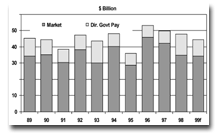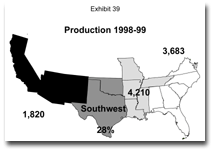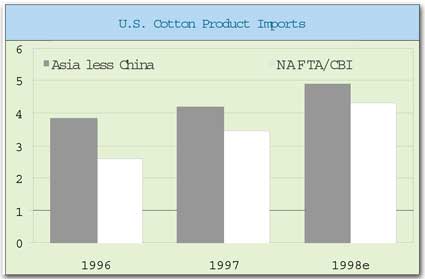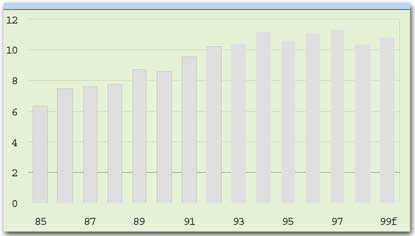The Year 2000 (Y2K) problem is emerging as one of the most expensive accidents in history. Its cost
will certainly exceed that of the Kobe as well as the Los Angeles earthquakes plus Hurricane Andrew
(only $170 billion).With only a matter of months left before the problem hits the world head-on,
most textile, apparel and fiber business owners continue to put off their Y2K projects. Where
We StandAccording to a recent survey by the National Federation of Independent Business (NFIB) and
Wells Fargo Bank, of 500 small businesses, only 41 percent had addressed or intended to address the
Y2K problem, and 18 percent of the companies said that they were not at all or barely aware of the
problem.The survey estimates that 82 percent of all small business owners are at risk because they
use computers; use time/date systems that might be affected; or sell, lease or install equipment
that could be impaired.Most small businesses think they know about Y2K, but they dont understand
the whole picture, said William Dennis, senior research fellow at NFIB. They dont know some of the
more technical aspects of the problem.According to Dennis, the end-of-the-world scenarios in the
general press arent helping to legitimize the problem. Small business owners see stories about
possible bank failures and airplanes falling out of the sky when what they need is more discussion
about specific consequences, he said.Those textile operations that are ready to tackle Y2K still
face two major dilemmas. The first is, obviously, that there is not a great deal of time left in
which to deal with the problem. Secondly, the fix can be expensive even for an apparel or fibers
business that is not particularly computer-dependent. All of which make the tax breaks available
more important than usual.
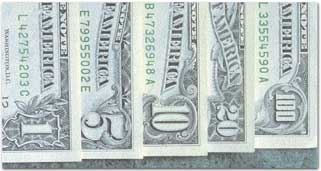
Computer-Fix Tax BreaksUnder our tax rules, the cost related to the development of software
for the textile operations own use or for sale or lease to others may be immediately deducted.Or,
if it is more advantageous, the operation may amortize the costs over a five-year period or an even
shorter period is appropriate. All our lawmakers require is that all computer software costs be
treated consistently.One caveat, however, is that today a textile or fibers operation that
acquires, rather than develops software, can depreciate it over 36 months if it meets all of the
following requirements:It is readily available for purchase by the general public;It is not subject
to an exclusive license; andIt has not been substantially modified.Even if the software does not
meet the above requirements, a textile business should depreciate it over 36 months if it was not
acquired in connection with the acquisition of all or a substantial part of a business.Anyone who
acquires software today must amortize it over 15 years (rather than depreciate it) if it does not
meet all of the requirements listed above and if the taxpayer acquired it in connection with
acquisition of a substantial portion of a business.It appears unlikely that there will be any
significant changes in our tax laws in the foreseeable future. The Clinton administration and
Congress are fighting over the disposition of the projected budget surplus and concerned with
saving Social Security and Medicare.Clintons Year 2000 budget calls for raiding taxes and expanding
government programs by cracking down on corporate tax shelters and cashing in on the settlement
between tobacco companies and U.S. states.Congress has adopted a budget outline that calls for
using the mounting budget surplus in Social Security payments to reduce the nations $3.3 trillion
in publicly held debt. The almost identical Senate and House budget plans would keep the strict
spending limits laid out in the 1997 balanced budget pact, leaving room for significant tax cuts or
new spending. Controversial Tax BreaksIn recent months, textile mills and business owners have
seen more than their fair share of controversial court decisions and Internal Revenue Service (IRS)
rulings involving key tax breaks. These included reversals by the U.S. Tax Court, dissenting
opinions and differing positions among the various appeals courts. And behind it all, the IRS
quietly pushes its agenda. Personal vs. BusinessTemporary rules issued by the IRS disallow a
tax deduction for the interest paid on overdue individual income taxes, even when the source of the
personal income is a trade or business.A 1996 Tax Court decision, held that the applicable
regulation conflicts with the Tax Court decision, several lower courts have sided with it in
finding the IRSs regulations to be invalid.Unfortunately, the U.S. Court of Appeals for the Ninth
Circuit, in a 1998 decision, overturned the Tax Court and concluded that the regulation is a
reasonable interpretation of a finically ambiguous statute. The Eighth Circuit the only other
appeals court to address the issue has also sided with the IRS. Although the question of tax breaks
for interest paid on the unpaid taxes of a mill owner is a narrow one, more controversial and
somewhat closer to home is the on-going problem of who is and who isnt an independent contractor.

Employee vs. ContractorThe big news here has been the rulings in the Microsoft vs.
Vizcaino case, preventing the software manufacturer from withholding benefits from workers it has
classified as freelancers.A divided Appeals Court for the Ninth Circuit upheld a three-judge panel
decision that workers classified by Microsoft as freelancers were entitles to participate in the
companys 401(k) and Employee Stock Purchase (ESOP) Plans.The employees in this case signed
employment contracts as independent contractors even though they all worked at the company for
years and performed the same work as permanent employees.It is not just high-tech companies, which
typically use larger numbers of such freelancers in code and software design, that will be affected
by this case in 2000.All businesses that give workers benefits and provide flexible work
arrangements must take note; and workers must review how many classifications will impact on 2000
contributions to both IRAs and employment taxes.On that age-old basic question of who is and who
isnt an independent contractor, however, the IRSs 20-point test and the safe harbor rules for
textile-related business operations remain intact.Although a few lawmakers have proposed making the
question of who is and who isnt easier, it appears unlikely that anything will happen to resolve
this issue completely.In an important pro-taxpayer ruling, reliance on legal tax advice triggered
safe-harbor relief. The IRS ruled in technical advice that a vision care companys reliance on legal
advice established a reasonable basis for not treating doctors of optometry as employees. A mill
that received similar advice would also, presumably, be allowed to continue treating its workers as
independent contractors. Capital Expense Or Just ExpenseEvery mill or business owner is aware
that expenses can be deducted immediately while those expenditures that are required to be
capitalized must be depreciated if they can be deduced at all.However, the IRS shows every intent
of continuing in 2000 to aggressively apply a 1992 Supreme Court decision to require capitalization
of many expenses.Business acquisition costs: Here the IRS has also decided that once a decision has
been made to acquire the business, virtually all costs incurred in an attempt to actually acquire
it are ineligible for five-year amortization and must be capitalized only to be recovered when the
business is eventually sold or otherwise disposed of.Asbestos removal cost: The Tax Court has
required costs for the removal cost of asbestos to be capitalized.Graphic design costs: The IRS did
lose one of its capitalized expenditure cases the Tax Court denied its attempt to require the
capitalization of graphic design costs for cigarette packages even though they may produce future
patronage or goodwill. Unfortunately, the IRS has announced that it will still pursue those who
attempt to deduct graphic design costs as advertising expenses rather than capitalizing them.
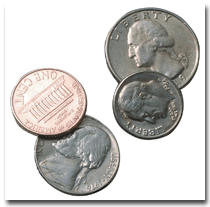
Questionable Tax BreaksOne of the basic principles of operating a textile business as a
corporation permits a shareholder to contribute capital to the incorporated business without
recognizing gain on the exchange. However, when it comes to contributing property with liabilities
in excess of its basis or book value, gain must be recognized to the extent of the excess.In an
about-face, the Tax Court in another case decided that excludable discharge-of-indebtedness income
realized by an insolvent S corporation does not flow through a shareholder in the form of any
increase in stock basis.Partnerships: Noting what it calls a rising level of abuse, the IRS has let
it be known that it intends to vigorously pursue valuation issues involving family limited
partnerships. The IRS is particularly concerned about dramatic discounts that have been taken for
family limited partnerships when the partnership assets consist of cash, cash equivalents,
marketable securities and similar liquid assets.Electronic travel records: As an accommodation to
todays increasingly paperless economy, the IRS interpreted the documentary evidence rule to not
require an original document, such as an airline ticket receipt, provided an employee also
established the amount, date, place and business character of the expenditure. Reducing
Taxable IncomeMany times a textile, apparel and fibers business owner can legitimately deduct
benefits that would otherwise be classified as nondeductible personal expenses. No textile business
owner should overlook the possibility of purchasing health insurance, investing for retirement or
providing perks like a company car through the business. But perks, particularly those that benefit
the owner of a closely-held textile operation, require advance planning.It should be kept in mind
that claiming some tax deductions may have an impact on the textile operations taxes in later
years. A good example of this is the recapture or payback of certain depreciation deductions that
are required when business property is sold. Depreciation deductions begin in the tax year in which
property is placed in service. Merely buying depreciable property during 1999 is not enough. To
claim the depreciation deduction, the property must be put into productive use in the fiber,
spinning or weaving business before the end of the year.All business real estate must be
depreciated using a mid-month convention. The property is treated as being placed in service in the
middle of the month in which it is actually placed in service. A depreciation deduction for
one-half of that month, plus the rest of the months for the remainder of the year. For most other
depreciable property other than real estate, a mid-year convention is used. This means that
regardless of what month the textile business starts using the property, it is treated as if use
began in the middle of the year. Generally, that means one-half of the first years depreciation,
regardless of when the property was placed in service.If Uncle Sam will allow one-half years tax
break for asset purchases made at anytime of the year, why not purchase all business assets and put
them to use in the final days of DecemberThat strategy would give you a half-years depreciation
while at the same time, avoiding an actual cash outlay until late in the year. The IRS is aware of
this possibility and imposes a so-called mid-quarter convention to prevent everyone from doing just
that.The mid-quarter rules apply if a textile mill puts more than 40 percent of their total newly
acquired property for the year into service in the last quarter. Any mill or business that does,
must use the mid-quarter convention for all assets placed in service during the year. Plan To
Pay The PiperEvery employer is required to withhold taxes from employees pay as well as deposit the
withheld amounts with the property tax agencies. Furthermore, as an employer, a textile operation
will also have to pay certain taxes on the amount paid to workers.Together, these taxes that every
operation is required to withhold and those that they are directly required to pay compromise the
operations payroll taxes. They may include Federal, state and perhaps, local income taxes, Social
Security, Medicare taxes, Federal and state unemployment taxes and, in some states, disability
insurance taxes.Plus, regardless of whether the textile operation employs others, some payroll-type
taxes due on income that the owner receives from the business. The key to controlling payroll tax
obligations is making all payments when they are due in order to avoid getting hit with costly
penalties.

Tax CreditsWhen they are available, tax credits are generally better for a textile
business than deductions. After all, credits reduce the apparel or fibers operations tax bill while
deductions merely reduce the income which that tax bill is computed.Today most tax credits are
narrowly targeted to encourage everyone to take certain actions that lawmakers have deemed
desirable (generally, to benefit disadvantaged low-income individuals or the environment). There
are also a few credits designed to prevent double taxation and a few designed to encourage certain
types of investments that are considered socially beneficial. Lower Tax RatesAlthough no
textile business or operation can actually lower its tax rate, there are opportunities that can
produce similar results in 2000:Choosing the optimal form of organization for the business (such as
sole proprietorship, partnership, corporation or S corporation.)Structuring a transaction so that
payments received are classified as capital gains. Long-term capital gains earned by non-corporate
taxpayers are subject to lower tax rates the other income.Shifting income from a high tax bracket
individual (such as the textile business owner) to a lower-bracket individual (such as the owners
child). One fairly simple way to accomplish this is by hiring your children. Another possibility is
to make one or more children partners in the textile business, so that net profits are shared among
a larger group.While the tax laws limit the usefulness of this strategy for shifting unearned
income to children under the age of 14, some opportunities to lower tax rates still do exist. But,
once again, the time to think about those strategies is during 1999, not 2000. Planning To
Avoid The AMTBecause some taxpayers most notably wealthy taxpayers have been so successful at
legally minimizing their taxbills, Congress came up with another way to tax them: the alternate
minimum tax (AMT). The AMT ensures that every textile business and individual will pay a tax no
matter how successful they are at using the benefits, deductions and credits in our tax law.If a
mill or textile business owner is too successful at planning his or her taxes using so called
preference items such as acceleration depreciation, capital gains, etc., the AMT is triggered.

Restrictions On Tax PlanningThe fact that a textile operation plans to use one form of
transaction rather than another in order to minimize taxes will not invalidate the transaction for
tax purposes. However, even if the form of a transaction is valid, the IRS may look at the
substance or true nature of the transaction in order to determine what the tax consequences should
be.The general rule is that the IRS may look behind the form of any transaction in order to
determine its substance for tax purposes. If the IRS doesnt agree with the taxpayer, they are
empowered to change that deduction. Taxpayers, however, are generally locked into the form of the
transaction. The thinking here is that since a taxpayer can freely choose how to set up a
transaction, its only fair to require him or her to live with the tax consequences.Despite the
restrictions and despite the fact that there will not, in all likelihood, be any significant tax
law changes to the plan for, everyone should immediately begin thinking how to reduce their 1999
income tax bills, those bills that will become due early in 2000.Incorporating tax planning into
the day-to-day operation of your textile business will enable you to achieve a low tax bill this
year and low tax bills for the next few years at least.
May 1999

